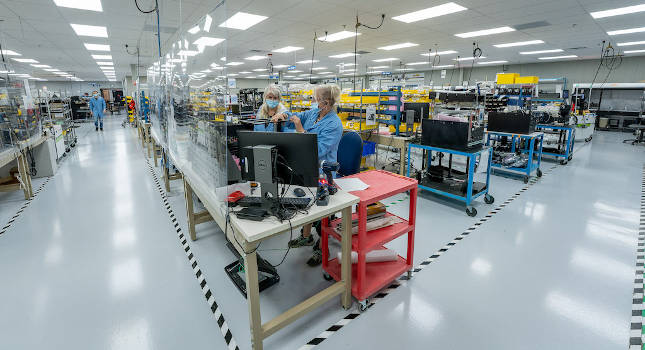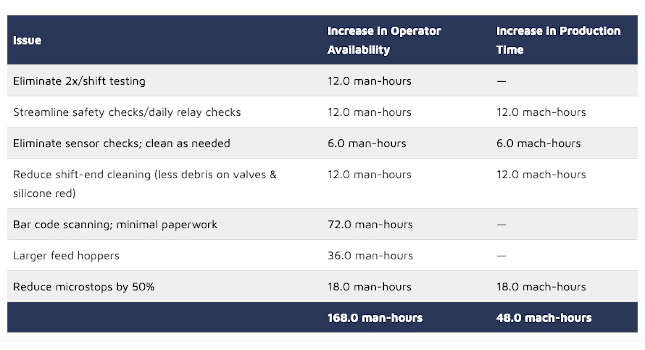Like soccer, a Lean daily management plan on a manufacturing floor requires team discipline to ensure success.

In a world of rapidly changing customer demands, an organization’s Lean daily management activities and the game of soccer have much in common. That’s according to those with experience in both arenas.
According to author Peter Loge (Soccer Thinking for Management Success: Lessons for Organizations from the World’s Game and www.SoccerThinking.com), concepts for soccer apply to companies and vice versa. It can be a valuable exercise to compare soccer to any system where everyone is part of a single unit and the parts are not interchangeable.
Defining Lean daily management
Whether the goal is to boost productivity on a product line, reduce service delays, efficiently fill custom orders or keep the ball in your team’s possession during a match, how we manage daily activities across our organizations is critical.
Lean daily management is the system and structure that companies develop to manage daily work. A daily management system must take into account customer demand, best practices and standards, equipment and the workplace, improvement and people.
In short, Lean daily management helps your team do what is important better.
Similar to play on the soccer pitch, Lean daily management gives ownership to team members who are closest to the work and ongoing events. On the field (or on the floor) team players can take a 360-degree view of the situation.
By empowering work teams to respond quickly to changing conditions, managers create an environment where continuous learning is accepted. Everyone knows they play an important role in the company’s progress.
It’s important that the work teams who contribute to their company’s Lean daily management system first need to know what “good” looks like. They must set and measure efforts against key performance indicators that matter. Key performance indicators (KPIs) such as safety, quality, delivery time, productivity and cost must be quantifiable. They must reflect critical success factors. They need to link to organizational goals. They must be agreed to beforehand. And they must be measured over time.
Who should do Lean daily management?
Everyone in the organization should do Lean daily management. Just as in a soccer match, in Lean daily management there is no waiting. Actions, information flow, measurements and improvements occur in in the moment. While management sets the team’s overall goals and objectives in a match or on the plant floor, it’s the team that manages daily work. The team facilitator may be the team leader or the supervisor. But the team also can choose him or her. The facilitator is often a worker and a coordinator. They become the information link and spokesperson. Same applies to Lean daily management activities in a company.
Many companies look at work teams organized in tiers.
In a small company, the tiers may look like this:
- Tier 1: Work team and team leader
- Tier 2: Team leaders and value stream manager
- Tier 3: Value stream managers, support managers and site manager.
In a large company, the tiers may look like this:
- Tier 1: Work team and team leader
- Tier 2: Team leaders and supervisor
- Tier 3: Supervisors, support staff and value stream manager
- Tier 4: Value stream managers, support managers and site manager.
10 elements of a daily management system
- Kaizen: Literally “change for the better,” is a cornerstone of Lean. Its philosophy and methodology helps organizations achieve sustainable growth through continuous improvement. Daily management systems incorporate:
- Visual management and displays: The tools that help show equipment status, show when help is needed or show the need for materials or supplies.
- Daily meetings (stand-up huddles): The pregame (or shift). What is off track? How do we correct it? What can we do ourselves and what do we need to escalate?
- Standardized work: Doing the right things correctly and consistently to keep the team efficient and on the same play. Documenting what is to be done, how and why.
- KPIs:Measuring (and improving on) the moves and actions that matter.
- Problem solving: Managers and team members ask for, receive, evaluate and provide feedback from other team members. How are we doing against our standards (KPI’s)? What’s needed (skills, equipment, time and so on) to get back on track?
- 5S: Organize and standardize the work environment. Keep only what the team needs in the work area and know where it is.
- Coaching:Building qualities in managers and team members that help them identify challenges, propose and implement solutions. On the soccer field and in companies, coaches assess readiness, give guidance and define next steps. In the process, they learn and grow as a coach.
- Gemba Walks: Whether it’s the production floor or the field, going to the source provides focus and clarity on expectations, balances safety, quality, delivery, cost and morale; aligns goals; creates a problem-solving culture.
- Leadership: Walking the talk. Positioning people to play to their strengths. Balancing the team’s talents and skills.



